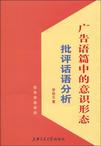广告语篇中的意识形态研究
出版时间:2009-10 出版社:上海交通大学出版社 作者:李桔元 页数:226 字数:214000
Tag标签:无
前言
广告自从产生以来,受到各个领域专家学者极大的关注,对其研究甚为广泛,其中大多数是从新闻学、传播学、经济学、美学及心理学等角度进行的。广告语言也以其独特的魅力引起了语言学界的兴趣。在国外,过去的50年中,出版了好几部有关广告语言的专著。研究范围包括英语广告的语音、语法和词汇特点,广告的符号学分析,广告语篇理解,广告的语体以及广告的语篇研究。国内也有一些学者对广告语言进行研究,从外语界的情况看,研究广告语言的角度主要有:词汇语法句式和修辞研究,文化研究,语体研究,语用研究,功能语言学研究等。国内外现有研究从不同层面和角度对广告语言进行了深入的探讨,揭示了广告语篇的词汇句法特点、语篇特点以及语用规律。 朱永生(2003)在回顾话语分析时指出,话语分析的任务之一就是揭示话语的语义结构与意识形态之间的关系。本书尝试从批评话语分析角度研究广告语篇中的意识形态。 批评话语分析认为,话语不但能传达信息、表达外在和内在的经验、建立人际关系,而且能用于表达价值观、信仰、态度。广告话语作为一种策略性公共话语,其特征是通过话语中的信仰、态度、支配等策略实现广告对读者的操纵。
内容概要
本书是语言学领域内有关批评话语分析的专著,也是第一本对广告语篇系统进行批评性研究的著作。批评话语分析是近年来国外发展迅速、国内正在兴起的一门关于语篇分析的理论与实践的学科。本书从理论上进一步厘清了批评话语分析的几个核心概念和结构体系,从实践上对作为公共语篇的广告语篇进行了较为系统的批评性分析,这在批评话语分析的具体应用上作出了有益的探索。
作者简介
李桔元,湖南新化人,文学博士,杭州师范大学外国语学院副教授,硕士生导师,中国高校功能语言学研究会会员。主要研究兴趣为功能语言学、语篇分析以及英语教学等。在外语类核心期刊及其它重要期刊上发表学术论文20余篇,参编省级规划本科教材和词典各1部,主持并完成省教育厅
书籍目录
AcknowledgementsList of Figures and TablesChapter One Introduction 1.1 Background of studies of advertising language 1.2 Research questions and significance of this study 1.3 Theoretical and methodological orientations of this study 1.4 Data collection 1.5 Organization of the dissertationChapter Two Theory Preliminaries 2.1 Introduction 2.2 Critical discourse analysis 2.2.1 From discourse analysis to critical discourse analysis 2.2.2 A survey of critical discourse analysis 2.3 The view of discourse in critical discourse analysis 2.3.1 Discourse vs. Text 2.3.2 Discourse as action 2.3.3 Discourse as ideologies 2.4 Ideology and power in language 2.4.1 Ideology 2.4.2 Power 2.4.3 The relationship among language, ideology and power 2.5 The text-oriented framework for analysing ideologies 2.5.1 Hallidayan paradigm : text functionality in context 2.5.2 Framework for analysing ideology in discourse: Fairclough' s three-dimension model 2.6 SummaryChapter Three Modality as Explicit Representation of Ideologies in Advertising Discourse 3.1 Introduction 3.2 The ideological nature of modality 3.3 Meaning dimensions and grammatical devices of modality 3.3.1 Meaning dimensions of modality 3.3.2 Grammatieal devices of modality 3.4 Modality and its ideological meanings in advertising discourse 3.4.1 Ideological meanings of modality in advertising disco urse: a case study 3.4.2 Modality distribution in advertising texts: empirical studies 3.5 SummaryChapter Four Personal system as Representation of Ideologies in Advertising Discourse 4.1 Introduction 4.2 The functions of personal pronouns:SFL perspective 4.3 The politics of some personal pronouns 4.3.1 "them and us" attitude 4.3.2 "me" and "you" :subjectivity or empathy 4.4 Ideological meanings of personal pronotms in ads 4.4.1 Characteristics of use of personal pronouns in ads 4.4.2 Personal pronouns work ideologically in building relations 4.5 SnmmaryChapter Five Transitivity as Implicit Representation of Ideologies m Advertising Discourse 5.1 Introduction 5.2 Transitivity as the construal of experience 5.3 Transitivity as representation of ideologies 5.4 Transitivity system and the power relations in advertising discourse 5.5 SummaryChapter Six Intertextnality as Representation of Ideologies in Advertising Discourse 6.1 Introduction 6.2 What is intertextuality 6.2.1 Bakhtin:dialogism and heteroglossia 6.2.2 Kristeva:intertextuality as dialogue between texts or text and social context 6.2.3 Other interpretations of the term "intertextuality" 6.2.4 Intertextuality and interdiscursivity 6.3 The ideological functions of intertextuality 6.4 Intertextuality as hegemonic struggle in advertising discourse 6.5 SummaryChapter Seven Conclusion 7.1 Summary of this dissertation 7.2 Major findings 7.3 Limitations of this study 7.4 Suggestions for further researchAppendicesBibliography
章节摘录
2.2.1 From discourse analysis to critical discourse analysis When we talk about critical discourse analysis, we tend to think of discourse analysis and connect them together just because they are, as two approaches to analysing discourse, to some degree similar but in nature quite different. These two approaches are both based on social constructivism, which holds the following premises: our knowledge of the world is not objective truth, but the product of discourse; discourse is a form of social action that plays a part in producing the social world——including knowledge, identities and social relations; knowledge is created through social interaction in which we construct common truths and compete about what is true and false ; different social understandings of the world lead to different social actions, and therefore the social construction of knowledge and truth has social consequences (Jorgensen & Phillips 2002 : 5-6 ). The emergence of discourse analysis as an approach to language is marked by Harris paper Discourse Analysis published in the periodical Language in 1952. But in the next 20 years, discourse analysis made limited progress. Zhu Yongsheng (2003) divides this period as the fetus stage, at which discourse analysis is brand-new to linguists and few attempts were made to analyze texts for lack of ready-made theories for guidance and lack of methods to abide by. It was not until 1970s that discourse analysis came into its own development stage.
编辑推荐
《广告语篇中的意识形态:批评话语分析》首先对国内外广告语言研究作了一个回顾并且分析了现有研究的局限性,然后提出《广告语篇中的意识形态:批评话语分析》的研究范围、目标以及理论取向和方法。其次对批评话语分析的理论进行综述,包括历史发展、理论流派,重点探讨了批评话语分析理论中的三个关键概念:话语、权力、意识形态以及三者之间的关系;最后描述了《广告语篇中的意识形态:批评话语分析》用于分析广告文本的理论框架。而后对广告语篇意识形态的多角度分析。最后对全书的讨论作总结,概述了研究发现、研究的不足。
图书封面
图书标签Tags
无
评论、评分、阅读与下载
用户评论 (总计1条)
- 是硕士论文或者博士论文,没想象当中有用
推荐图书
- 易经
- 道德经·通玄经
- 科技税收优惠与纳税筹划
- 中国西部区域发展路径
- 金银湿法冶金及分析测试方法
- 混凝土贯入阻力测定仪 JT/T 756-2009
- 水泥混凝土拌合物含气量测定仪JT/T 755-2009
- 水泥混凝土拌合物含气量测定仪 JJG(交通)0
- 李氏密度瓶 JT/T 753-2009
- 李氏密度瓶 JJG(交通)092-2009
- 姨妈的后现代生活
- 雷氏夹及雷氏夹膨胀测定仪 JJG(交通)093-2009
- 雷氏夹及雷氏夹膨胀测定仪 JT/T 754-2009
- 基础日语
- 每天读点胡雪岩全集
- 机械故障诊断中的现代信号处理方法
- 轨道力学
- 地下水运动数学模型
- 山江湖工程创新技术与方法
- 实用消化系肿瘤学
- 半知菌分属图册
- 大型水电站蜗壳结构设计理论与工程实践
- 第二语言语用能力的发展
- 500位世界顶级管理者的成功秘诀
- 厚黑学
